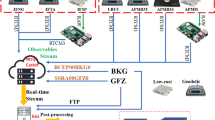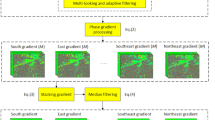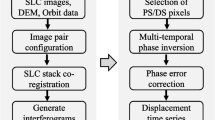Abstract
The increased frequency of flooding in the metropolitan area of São Paulo (MASP), São Paulo, Brazil, makes it necessary to have an accurate precipitation monitoring and nowcasting system to mitigate socioeconomic impacts. This research is on the use of remote sensing with dual Doppler X-band weather radar (MXPOL) to improve the high spatiotemporal resolution rainfall rates estimation in MASP. The methodology includes an initial correction of the polarimetric data, namely, the specific differential phase (KDP) to estimate the attenuation correction, the adjustment of rainfall rates by polarimetric variables relationships, and the error estimation by cross-validation with rain gauges. Results show that the five relationships have similar performance with just a slight difference between the use of power relationships (e.g., reflectivity (Z) and differential reflectivity (ZDR)) or frequency (e.g., specific differential phase) variables. The average error was 1.1 mm for the mean square error, 29% for the relative error, and 0.8 for the correlation coefficient. An adjustment of coefficient specifically for MXPOL was significantly advantageous for the rainfall rate estimation with R (Z, ZDR) and R (ZDR, KDP) relationships.








Similar content being viewed by others
References
Anagnostou, E. N., et al. (2004). High-resolution rainfall estimation from X-band polarimetric radar measurements. Journal of Hydrometeorology, 5(1), 110–128.
Arnaud, P., Lavabre, J., Fouchier, C., Diss, S., & Javelle, P. (2011). Sensitivity of hydrological models to uncertainty in rainfall input. Hydrological Sciences Journal, 56(3), 397–410. https://doi.org/10.1080/02626667.2011.563742
Bringi, V. N., & Chandrasekar, V. (2001). Polarimetric doppler weather radar—principles and applications. Cambridge University Press.
Bringi, V. N., Keenan, T. D., & Chandrasekar, V. (2001). Correcting C-band radar reflectivity and differential reflectivity data for rain attenuation: a self-consistent method with constraints. IEEE Transactions on Geoscience and Remote Sensing, 39(9), 1906–1915.
Cifelli, R., Chandrasekar, V., Chen, H., & Johnson, L. E. (2018). High-resolution radar quantitative precipitation estimation in the san francisco bay area: rainfall monitoring for the urban environment. Journal of the Meteorological Society of Japan, 96A, 141–155. https://doi.org/10.2151/jmsj.2018-016
Diederich, M., et al. (2015). Use of specific attenuation for rainfall measurement at X-band radar wavelengths. Part II: Rainfall estimates and comparison with rain gauges. Journal of Hydrometeorology, 16(2), 503–516.
Instituto Florestal (2020). Serviços Ecossistêmicos e Bem-Estar Humano na Reserva da Biosfera do Cinturão verde da Cidade de São Paulo. Editors: Elaine Aparecida Rodrigues, Rodrigo Antonio Braga Moraes Victor, Bely Clemente Camacho Pires, Edgar Fernando de Luca. 608 p. ISBN: 978-85-64808-21-8. Available in Portuguese at: https://www.infraestruturameioambiente.sp.gov.br/institutoflorestal/2020/12/servicos-ecossistemicos-e-bem-estar-humano-na-rbcv/.
Ferreira, A. T. (2010). Análise dinâmica, termodinâmica e microfísica de uma linha de instabilidade com o radar meteorológico móvel MXPOL. [s.l.] Universidade de São Paulo
Farias, J. F. S., & Pereira Filho, A. J. (2013). Rainfall short-term forecast in the surveillance area of São Paulo weather radar. Revista Brasileira de Meteorologia, 8(2), 199–209. https://doi.org/10.1590/S0102-77862013000200009
Jacobi, S., & Heistermann, M. (2016). Benchmarking attenuation correction procedures for six years of single-polarized C-band weather radar observations in South-West Germany. Geomatics, Natural Hazards and Risk, 7(6), 1785–1799.
Krajewski, W. F., & Smith, J. A. (2002). Radar hydrology: Rainfall estimation. Advances in Water Resources, 25(8–12), 1387–1394. https://doi.org/10.1016/S0309-1708(02)00062-3
Marshall, J. S., & Palmer, W. M. K. (1948). The distribution of raindrops with size. Journal of Meteorology, 5(4), 165–166.
Matrosov, S. Y., et al. (2002). X-band polarimetric radar measurements of rainfall. Journal of Applied Meteorology, 41(9), 941–952.
Matrosov, S. Y., Heymsfield, A. J., & Wang, Z. (2005). Dual-frequency radar ratio of nonspherical atmospheric hydrometeors. Geophysical Research Letters, 32, 13816.
Nash, J.C. (1990). Compact numerical methods for computers: linear algebra and function minimization. [sl] Hilger
Park, S. G., et al. (2005). Correction of radar reflectivity and differential reflectivity for rain attenuation at X Band. Part I: Theoretical and empirical basis. Journal of Atmospheric and Oceanic Technology, 22(11), 1621–1632.
Park, S. G., et al. (2005). Correction of radar reflectivity and differential reflectivity for rain attenuation at X band. Part II: Evaluation and application. Journal of Atmospheric and Oceanic Technology, 22(11), 1633–1655.
Pereira Filho, A. J. (2012). A mobile X-POL weather radar for hydrometeorological applications in the metropolitan area of São Paulo Brazil. Geoscientific Instrumentation, Methods and Data Systems, 1(169–183), 2012. https://doi.org/10.5194/gi-1-169-2012
Pereira Filho, A.J., et al. (2005). The hydrometeorological forecast system for the Metropolitan Area of Sao Paulo. In World Weather Research Symposium Program on Nowcasting and Very Short Forecasting. Annals. Toulouse, France: Meteo France (CDROM).
Pereira Filho, A.J., et al., (2007). An operational mobile XPOL for hydrometeorological applications in Brazil. In 33rd Conference on Radar Meteorology. Proceedings, Cairns, Australia.
Pereira Filho, A. J., Carbone, R. E., Janowiak, J. E., Arkin, P., Joyce, R., Hallak, R., & Ramos, C. G. M. (2010). Satellite rainfall estimates over South America—possible applicability to the water management of large watersheds. The Journal of the American Water Resources Association, 46(2), 344–360. https://doi.org/10.1111/j.1752-1688.2009.00406.x
Pereira Filho, A.J. et al., (2013). Measurements of drop size distribution in a megacity. In: 36th Conference on Radar Meteorology. Proceedings, Breckenridge, CO.
Pereira Filho, A. J., Vemado, F., Vemado, G., Reis, F. A. G. V., Giordano, L. C., Cerri, R. I., Santos, C. C., Lopes, E. S. S., Gramani, M. F., Ogura, A. T., Zaine, J. E., Cerri, L. E., Augusto Filho, O., Daffonseca, F. M., & Amaral, C. S. (2018). A step towards integrating CMORPH precipitation estimation with rain gauge measurements. Advances in Meteorology. https://doi.org/10.1155/2018/2095304
Petersen, W. A., Carey, L. D., Rutledge, S. A., Knievel, J. C., Doesken, N. J., Johnson, R. H., McKee, T. B., Haar, T. V., & Weaver, J. F. (1999). Mesoscale and radar observations of the fort collins flash flood of 28 July 1997. Bulletin of the American Meteorological Society, 80(2), 191–216.
Proakis, G. P., & Manolakis, D. G. (1992). Digital signal processing: Principles, algorithms and applications. New York: Macmillam, pp 169, 411 and 585
Pruppacher, H. R., & Beard, K. V. (1970). A wind-tunnel investigation of the internal circulation and shape of water drops falling at terminal velocity in air. Quarterly Journal of the Royal Meteorological Society, 96(408), 247–256.
Raghavan, S., (2003). Radar Meteorology. [sl] Dordrecht: Springer.
Refaeilzadeh P., Tang L., & Liu H. (2009). Cross-validation. In Liu L., Özsu M.T. (eds) Encyclopedia of database systems. Springer.
Rosenfeld, D., & Ulbrich, C. W. (2003). Cloud microphysical properties, processes, and rainfall estimation opportunities. Meteorological Monographs, 30(52), 237–237.
Ryzhkov, A. V., & Zrnić, D. S. (2019). Radar polarimetry for weather observations (p. 486). Springer International Publishing.
Teixeira, E., & Haddad, E. A. (2013). Mapeamento das Perdas Econômicas Potenciais dos Pontos de Alagamento do Município de São Paulo, 2008–2012. São Paulo.
Testud, J., et al. (2000). The rain profiling algorithm applied to polarimetric weather radar. Journal of Atmospheric and Oceanic Technology, 17(3), 332–356.
Thurai, M., Mishra, K. V., Bringi, V. N., & Krajewski, W. F. (2017). Initial results of a new composite-weighted algorithm for dual-polarized x-band rainfall estimation. Journal of Hydrometeorology, 18(4), 1081–1100.
Tokay, A., D’Adderio, L. P., Porcù, F., Wolff, D. B., & Petersen, W. A. (2017). A field study of footprint-scale variability of raindrop size distribution. Journal of Hydrometeorology, 18(12), 3165–3179.
Wang, Y., & Chandrasekar, V. (2010). Quantitative precipitation estimation in the CASA X-band dual-polarization radar network. Journal of Atmospheric and Oceanic Technology, 27(10), 1665–1676.
Wijayarathne, D. B., & Coulibaly, P. (2020). Identification of hydrological models for operational flood forecasting in St John’s, Newfoundland, Canada. Journal of Hydrology: Regional Studies, 27, 100646. https://doi.org/10.1016/j.ejrh.2019.100646
Wu, W., et al. (2018). A dynamical Z-R relationship for precipitation estimation based on radar echo-top height classification. Advances in Meteorology. https://doi.org/10.1155/2018/8202031
Acknowledgements
The authors are grateful to Departamento de Energia Elétrica (DAEE) for providing the rain gauge datasets. The first author was supported by Coordination for the Improvement of Higher Education Personnel (CAPES) and the second by Conselho Nacional de Desenvolvimento Científico e Tecnológico (CNPq), under grant 302349/2017-6. The MXPOL system and research were sponsored by The State of Sao Paulo Research Support Foundation (FAPESP) under granted 13952-2.
Funding
The Funding has been received from Coordenação de Aperfeiçoamento de Pessoal de Nível Superior; Conselho Nacional de Desenvolvimento Científico e Tecnológico with Grant no. 302349/2017-6.
Author information
Authors and Affiliations
Corresponding author
Additional information
Publisher's Note
Springer Nature remains neutral with regard to jurisdictional claims in published maps and institutional affiliations.
Rights and permissions
About this article
Cite this article
Morell, D.A., Pereira Filho, A.J. & Beltrán, R.P. Quantitative Rainfall Estimation with a Mobile XPOL Weather Radar. Pure Appl. Geophys. 179, 2957–2968 (2022). https://doi.org/10.1007/s00024-022-03037-5
Received:
Revised:
Accepted:
Published:
Issue Date:
DOI: https://doi.org/10.1007/s00024-022-03037-5




